AMAZING TECHNIQUES IN SHAOLIN KUNGFU

|

|
| Double Dragons Carry Pearl | Poisonous Snake Basking in Mist |
Beautiful Patterns for Combat
Some people may think that many Shaolin Kungfu patterns are only decorative.
You may be amazed at how profound they are in overcoming complex situations.
The kungfu patterns above and below show five examples from the famous Shaolin Five Animals, from which much of the form and spirit of Shaolin Kungfu are derived.
The Dragon form, expressed above in the double dragon-claws, is instrumental for the training of shen, or mind. The Snake form, expressed in the finger-thrust, is instrumental for the training of chi, or energy.
The Tiger form, expressed in the tiger-claws, is instrumental for the training of gu, or internal force. The Leopard form, expressed in the leopard-punch, is instrumental for the training of li, or strength and speed. The Crane form, expressed in the crane-beaks and kick, is instrumental for the training of jing, or essence and elegance.
If you, like many people, think that these beautiful forms are merely for demonstration, and useless for combat, you will be in for a surprise. In fact, they are what they are because of their combative function; they were never invented for decoration. Indeed, it is shameful if students merely perform them to please spectators. These patterns are more beautiful in their combat function than in their appearance.

|

|

|
| Two Tigers Subdue Dragon | Golden Leopard Turns Around | Single Legged Hungry Crane |
Marvellous Techniques Beget Marvellous Techniques
How these patterns can be used for combat is explained in Is Shaolin Kungfu too Flowery for Combat? This webpage is a continuation of that one, explaining how, if you have been maneuvred into an apparently hopeless situation by a competent fighter using one of these patterns, you may not only escape from the difficult situation but emerge from it as the victor. This turning of the table against the opponent from a situation where many people would have encountered defeat is an example of the Shaolin principle “Marvellous techniques beget marvellous techniques.” The corresponding principle, with which the two form a poetic couplet, is “Wondrous skills generate wondrous skills.”
In Chinese the two principles sound as follows:
- miao fa fa zhong sheng mia fa; qi gong gong shang jian qi gong— in Mandarin pronunciation
- miu fatt fatt chung shang miu fatt; kei kung kung sheong kin kei kung— in Cantonese.
For example, when my master, Sifu Ho Fatt Nam, taught me the Shaolin Cosmos Palms, I wondered what the seemingly simple training method could achieve. Later when I could break a brick without having to undergo any tough conditioning, I was amazed at the apparently simple method. I was more amazed when I discovered that my senior classmates were so much more powerful just by practicing the similar method, but for a much longer period. My amazement was even greater when years later I could use my Cosmos Palms to cure many people of their so-called incurable diseases.

|
| Double Dragons Carry Pearl |
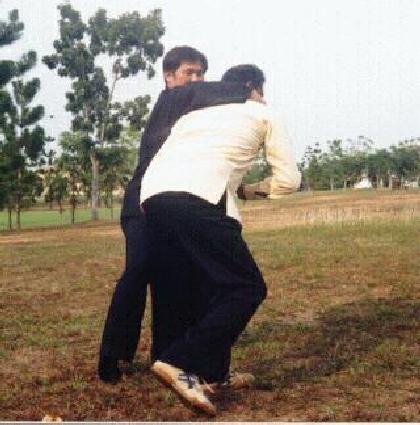
|
| Lion Turns Head |
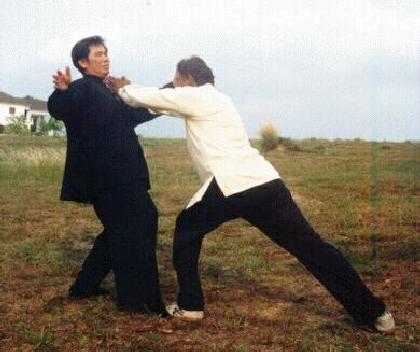
|
| Child Worships Buddha |
Turning the Table against your Opponent
In the first picture above, I could dislocate Mogan's head, possibly killing him, if I turn my hands accordingly — an action which I, as a Shaolin disciple, would not do. This pattern is called “Double Dragons Carry Pearl”. I have maneuvred Mogan into an awkward position, and have caused him to loose balance. (Notice that the leg on the far left is Mogan's right leg; my right leg is behind and between his.) Mogan could not use his hands, nor legs nor any part of his body to strike me. He is in a precarious position.
Yet, with a twist, Mogan turns the table around against me. Following the momentum of my turning hands, Mogan turns accordingly, bringing his left leg sharply backward to place it in between my legs and turning left around, as in the second picture. Simultanwously he presses his two palms together as in prayer and shoves them out. This shoving of his hands, a pattern known as “Child Worships Buddha”, not only releases my hold on his head but also strikes me at my throat, as in the third picture.
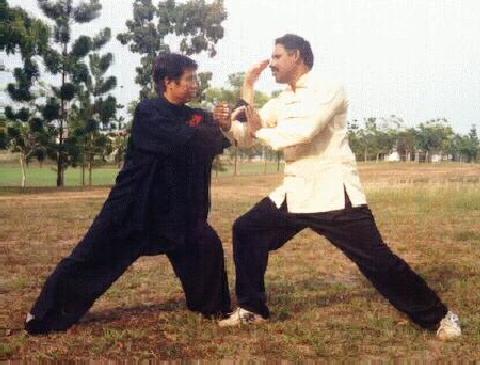
|
| Snake Basking in Mist |

|
| Two Tiger Catches Snake |
Simple yet Profound
In the first picture above I use my right hand to “tame” Mogan's two hands, making it technically impossible for him to block the simultaneous attack of my other hand, known as “Poisonous Snake Basking in Mist”, which is slicing his eyes with my fingers — again as a Shaolin disciple, I would not really do. If Mogan moves his head backward, I could shoot out my fingers and strike his eyes; if he moves his head to the left or the right, I would also follow accordingly.
If he tries to retreat by moving one or both legs, or by jumping back, I would follow suit, sticking to him with my fingers targetting at his eyes or throat. Even if Mogan closes his eyes, he may not escape injury, as I could still thrust two fingers into the sockets or into his throat. In reality, of course, such savage techniques are not carried out by Shaolin disciples; they merely tap the opponent on his skin.
Yet, with a twist, Mogan turns impending defeat to victory. He sinks down from the Bow-Arrow Stance to the Horse-riding Stance and simultaneously “leaks” his two hands below and around my “taming” right hand, and grips my attacking left hand at its weakest spots, namely the wrist and the elbow, with his two tiger-claws. His sinking into the Horse-Riding Stance, without moving his feet, not only places his head a safe distance from my left hand attack, but also generates internal force for his tiger-claws to grip and injure my left arm, thus foiling my intended forward thrust of my left hand.
In this position I could not strike him with my right hand or any part of my body; if I try to, all he has to do is to move my left arm accordingly to frustrate my strike, while deepening his grip and further injurying my arm. If I try to kick him with any of or both my legs, he would move his right leg a large step backward, pulling me to fall forward, then immobilize me on the ground. His pattern, called “Tiger-Claws Catch Snake”, appears so simple, yet is so profound.
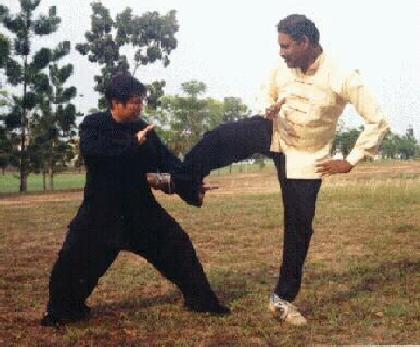
|
| Laying a Trap |
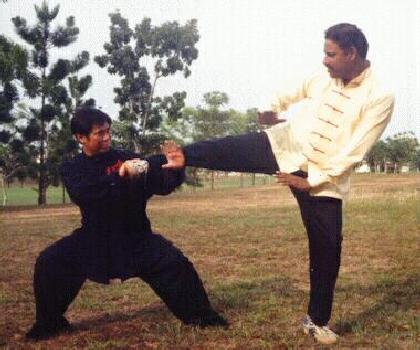
|
| Happy Bird Hops up Brance |

|
| Tiger Tail Kick |
Tiger-Tail Kick
In the first picture Mogan is about to execute a side-kick known in Shaolin Kungfu as “Happy Bird Hops up Branch”. I counter with “Two Tigers Subdue Dragon”, trapping his leg at its full extent, as in the second picture. From here I could have a few alternative follow-ups, such as dislocating his ankle, gripping deeply into vital points on his foot, fracturing his leg, kicking him with one of my legs, or pushing or pulling him to cause him fall over.
Many exponents of other martial arts would find this ends their combat, as they would not know what to do. Indeed, many exponents who often use this side-kick technique, comment that it is impossible for their opponents to trap their legs in a real fight. When pressed to explain what they would do if they were caught in such a situation, their reply frequently was “see who is faster”, suggesting, rather arogantly, that their kicks were always faster than their opponents' response, and tacitly conceding that they could do nothing else.
The third picture illustrates one way in Shaolin Kungfu to overcome this combat situation. Mogan turns his body anti-clockwise, bends his right knee, places his both hands on the ground to support his body, and kicks back his left leg at my abdominal energy field, front knee, chest or face, depending on which spot offers him the best target. This pattern is an example of the famous Shaolin Tiger-Tail Kick. I have to release my grip on his right foot so as to move away from his back thrust kick. Mogan then rolls away to safety.
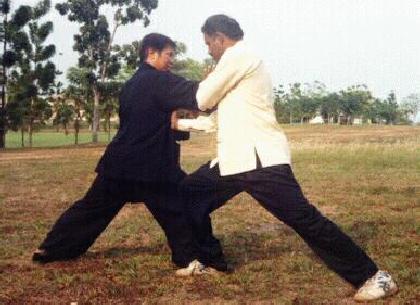
|
| Dragon Palm Strike |
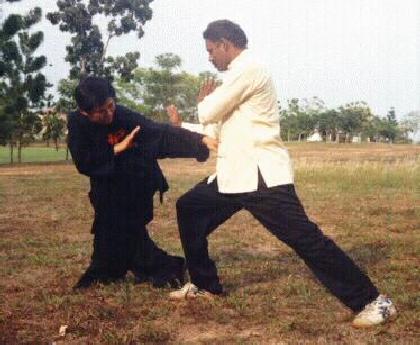
|
| Golden Leopard Turns Around |

|
| Tiger Tail Kick |
No Defence, Direct Counter
In the first picture above, Mogan covers my two arms and simultaneously attacks the internal organs behind my ribs with a dragon palm strike from close quarters. The palm strike executed by an exponent with internal force can cause tremendous damage at very close range.
I make a left about turn, as in the second picture, and rams a leopard punch at Mogan's abdominal energy field, using a pattern in Shaolin Kungfu called “Golden Leopard Turns Around.” This mode of counter employs the combat principle of “No defence, direct counter”, i.e. I do not bother to block or dodge the opponent's attack, and counter-strike immediately, my movement itself foils the opponent's attack.
Mogan's response is simple yet profound. He also employs “No defence, direct counter”, using a Shaolin kungfu pattern known as “False Leg Hand Sweep”, as in the third picture. He moves his front leg a small step backward, but still places it in front, and simultaneously chops at my extended elbow with a hand sweep. This apparently simple technique, but must have evolved through the centuries to its present crystalized form, can dislocate my elbow or fracture my arm with just one clean stroke, executed at the golden opportunity when “the opponent's old strength is spent, and his new strength has not manifested.”

|
| Single Legged Hungry Crane |
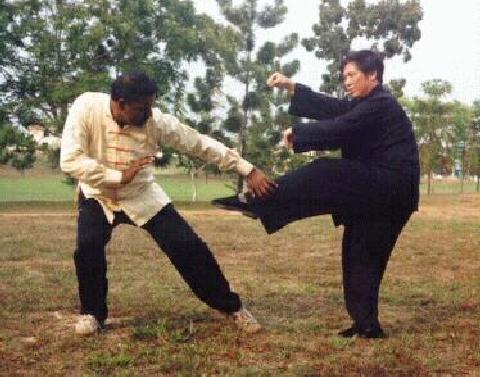
|
| Enter Sea to Search for Shells |
As Mogan attacks me in the first picture above, I hook his attack with my left crane-beak, and strike his eye with my right crane-beak, while my left foot kicks at his groin, in a Shaolin kungfu pattern known as “Single Legged Hungry Crane.” If he tries to ward off my top crane-beak attack, he will be hit at the bottom by my “organ-seeking kick.” If he tries to wards off my kick, his eye will be hit.
If he tries to retreat, I would jump in with the kicking leg, and kick him with the other leg, while my attacking crane-beak will cover his two hands and my other hand will strike his eye with another crane-beak. Such continuous multiple attacks, especially when the opponent's hands are covered and the exponent moves in closely each time the opponent retreats, is formidable.
In Shaolin Kungfu, however, there are amazing techniques to overcome such formidable situations. One example is shown in the second picture, using the pattern called “Enter Sea to Search for Shellfish.” Without moving his feet, Mogan shifts his body backward, thus avoiding both the top and the bottom attack in one move, and simultaneously sweeps his left tiger-claw at my kicking leg, catching and gripping my calf from behind as my leg moves upward.
It is amaziang what a seemingly simple pattern can do. Not only Mogan has in one simple move avoided my simultaneous top and bottom attacks, he also has completely reversed the technical advantage I just had. In this new situation, even if I could dodge his tiger-claw grip on my calf, it would now be disadvantageous for me to implement my earlier plan of jumping in with continuous multiple attacks. As he has not moved back, the process of my jumping in would make me an easy target for him.
More seriously, standing only on one leg and with my crane-beaks dangling in the air, I am in a vulnerable position. There are numerous ways Mogan could follow up with a coup de grace, such as squarting down and gripping my groin with his other tiger-claw, kicking at my groin or knee with his leg, or flipping me over and immobilizing me on the ground. But if I am well trained in Shaolin Kungfu, I can apply the principle of “Marvellous techniques beget marvellous techniques” and turn back the tables on him.
Such moves, incidentally, illustrate that advanced kungfu patterns are needed; straight-forward punching, kicking and blocking would be inadequate for such complex situations. But such advanced kungfu patterns are simple, direct and effective, although they may appear flowery to the uninitiated — they are devoid of unnecessary frills.
Many people have written to enquire about the possibility of learning Shaolin Kungfu, Chi Kung or Taijiquan (Tai Chi Chuan) from Sifu Wong Kiew Kit. Please refer to the respective intensive courses for details.
